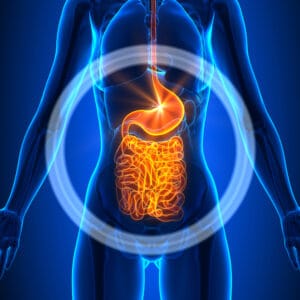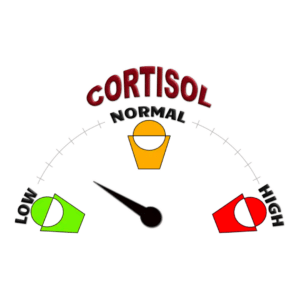Hormone balance is crucial to virtually all bodily functions, including sex and reproduction, growth and development, sleep and mood. You will know if your hormones are in balance, because if they are, you will look great, feel great, have loads of energy, a healthy sex drive, and appetite. Hormonal imbalance, such as through oestrogen dominance, can affect your mood, energy and weight, and can over time lead to more serious conditions, such as hormone-positive breast cancers.1
Hormonal imbalance can affect your mood, energy and weight, and can over time lead to more serious conditions, such as hormone-positive breast cancers.
Oestrogen dominance occurs when there is too much of the aggressive oestrogen (oestrone and oestradiol), as compared to the protective oestrogen (oestriol). Alternatively, when the ratio of progesterone to oestradiol is too low, meaning we do not produce enough progesterone, and oestradiol becomes dominant.
Oestrogen is primarily produced by the ovaries, but after menopause, it is produced by fat cells and adrenal glands. Progesterone is made from cholesterol and from the ‘corpus luteum’ (which is what is left of a follicle after a woman ovulates). We can’t function without these two hormones and can only function well when they are in a delicate balance.2
Symptoms of oestrogen dominance are:
- PMS;
- endometriosis;
- irregular periods;
- cellulite,
- infertility;
- thyroid nodules;
- breast lumps;
- fibroids;
- ovarian cysts.
Conditions that have been linked to oestrogen dominance include breast cancer, uterine cancer, autoimmune diseases and infertility.3
Some of the following factors can lead to oestrogen dominance:
- eating non-organic foods, which contain high amounts of pesticides, fertilisers, growth hormones, and antibiotics – because these are all hormone disruptors (similar in structure to natural sex hormones, such as oestrogen, thereby interfering with their normal function);
- too much exposure to environmental xenoestrogens – a number of chemical compounds found in consumer products like plastics, detergents and skin-care products;
- synthetic oestrogens such as the birth control pill and HRT;
- detoxification issues;
- chronic stress;
- poor diet;
- poor liver function;
- drugs, smoking, alcohol.
Strategies to avoid oestrogen dominance
- Test for oestrogen dominance
Consult a healthcare practitioner to test for oestrogen dominance. Be sure to get saliva, not blood testing, because blood samples won’t get the “free” (unbound) hormones, but only “total”, which is not indicative of the amount of hormone that is actually free and ready to go to work in your tissues. You can find out more about this here.
- Go organic
Most chemical compounds contained in pesticides and fertilisers are hormone disruptors, so be sure to eat mostly organic. If you are on a tight budget, check out the Dirty Dozen and Clean Fifteen Lists compiled by the Environmental Working Group, and be guided by them (ewg.org).
- Eliminate xenoestrogens
Compounds contained in general consumer products such as lotions, creams, shampoos, hairsprays and perfumes have chemical structures similar to oestrogens, which imitate natural oestrogens and exert oestrogen-like effects.
Other xenoestrogens include paint removers, glues, herbicides, fungicides, plastics, dry-cleaning chemicals and adhesives found in nail polish.
- Improve your liver function
Poor liver function causes an inadequate breakdown of older hormones allowing them to recirculate in an even more toxic form than when they originally entered the liver. These more toxic forms of oestrogen increase the risk for breast cancer, endometriosis, ovarian cysts, prostate issues, menopause and thyroid disorders.
The following are anti-oestrogenic foods that have been shown to help the body detoxify oestrogens:
- cruciferous vegetables such as cauliflower, broccoli, Brussels sprouts and cabbage – these contain rich sources of sulphur-containing compounds; 4
- anti-inflammatory foods that are rich in saturated and omega-3 fatty acids such as organic beef and dairy, and wild Alaskan salmon; 5
- plant based fats such as coconut oil, avocados and olive oil; 6
- raw nuts and seeds such as chia seeds, pumpkin seeds, hemp seeds; 7
- herbs such as oregano, thyme, rosemary, sage and turmeric. 8
- Consult a registered nutritional therapist to discuss supplements for the healthy elimination of xenoestrogens and the encouragement of healthy oestrogen metabolites
If you think you might be experiencing hormonal imbalances and want to discuss this with Andy further, you can get in touch here: andy@thesugardoctor.co.uk.
REFERENCES:
- Folkerd E, Dowsett M (2013). Sex hormones and breast cancer risk and prognosis. Breast 2: 538-543;
- Jerry D (2000). Roles for estrogen and progesterone in breast cancer prevention. Breast Cancer Resolution 9(2):102;
- Ziel H (1982). Estrogens role in endometrial cancer.Obstetrics and Gynaecology 60(4):509-515;
- Higdon J, Delage B, Williams D, Dashwood R (2007). Cruciferous vegetables and human cancer risk: epidemiologic evidence and mechanistic basis. Pharmacology Resolution 55(3): 224-236;
- Sears B (2015). Anti-inflammatory diets. Journal of the American College of Nutrition. 1:14-21;
- Zakana Z, Rafiee M, Somanit M (2011). Hepatoprotective activity of dried and fermented processed virgin coconut oil. 2011: 142739;
- Guan Y, He Q (2015). Plants consumption and liver health. Evidence based complimentary and alternative medicine 2015:824185;
- Allen J, Montalto M, Lovejoy J,Weker W (2011). Detoxification in naturopathic medicine: a survey. Journal of alternative and complimentary medicine 17(2): 1175-1180








